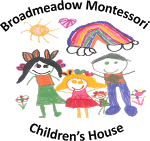Childhood Education in Broadmeadow
Great care is taken to create a learning environment that reinforces the child’s independence and natural urge toward self-development. Rather than “teaching” the child facts and concepts, the thoughtfully “prepared environment” is designed to stimulate the child’s interests and facilitate natural learning. Intrinsically motivated and curious to explore, the child learns through direct experiences and hands on learning using concrete materials. Each piece of material has a specific purpose, and is presented to the children in a manner that will enable them to direct their own learning. This self-education establishes a sense of order, logical thought processes, concentration, persistence, discipline, self-confidence and lays a firm foundation for lifelong learning.
The classroom is not merely a place for individual learning. It is a vibrant community of children, where the child learns to interact socially in a variety of ways. The multi age grouping enables older children to teach the younger and learn much themselves from the experience, while the younger children are inspired to more advanced work through observing the older ones. With such a variety of levels in the classroom, each child can work at his or her own pace, unhindered by competition and encouraged by co-operation. Guidance and support are given by educators through one-on-one presentations and small group lessons. The environment is organized into the following curriculum areas: Practical Life, Sensorial, Mathematics, Language and Culture.

Practical Life
Practical life provides the link to the home environment. The materials involve the children in precise movements that challenge them to concentrate, work at their own pace uninterrupted and complete a cycle of work that typically results in the feelings of satisfaction and confidence. The activities help the children to become independent and thus be able to do things for themselves. They also help in the child’s development and co-ordination of movement.
“Adults work to finish a task, but the child works in order to grow and is working to createthe adult, the person that is to be” –Montessori

Sensorial
Children live in a world of senses. Sensorial education helps refine the child’s senses so that the child can differentiate even the slightest differences in order to truly observe and appreciate the world around them. The sensorial materials “highlight” impressions they have already gained. Each piece of equipment is generally a set of objects, which isolate a fundamental quality perceived through the senses such as colour, dimension, texture, temperature, volume, pitch, weight and taste. Each exercise specifically isolates one sense at a time, to maximize its refinement. The sensorial material is really a key to the world and is the basis for abstraction. Montessori felt far more could be experienced by the child/adult if they were capable of discerning and appreciating fine differences in stimuli. These materials give the child concrete experiences which are the “building blocks” for abstraction in language, maths and cultural subjects as the child grows older.

Mathematics
Dr. Montessori developed the use of concrete materials to help children to understand abstract concepts. In small sequential steps, each learner develops a mathematical mind at his own pace. He visually sees and manipulates with his hands and learns about dimension, size, number, shape and sequence. Each step provides a new challenge and slowly leading him to the abstract –providing a superior understanding.
“Children show a great attachment to the abstract subjects when they arrive at them through manual activity. The satisfaction leads to an enthusiastic interest in numbers when the child is able to demonstrate fundamental mathematical operations, rather than simply being told dull and meaningless facts. He physically holds the quantities that he sees represented by written symbols. He combines the materials, counts, separates and compares them while visually grasping and reinforcing the ideas in a way that is concrete, rather than abstract.” -Maria Montessori

Language
Language provides the key that uncovers, conserves and synthesises knowledge. Using the sandpaper letters the children are able to effortlessly link sounds, symbols, their shapes and their written formation. They are also introduced to grammar.
The child grows in appreciation of the mystery and power of language. “Once we have language at our disposal, we have a key which will unlock many doors”

Culture
The cultural materials hold a great fascination for the young child and it provides the initial exposure to acquire an early interest in learning about the world, its natural wonders, its people, history, culture, music and art.
They learn about the world around them, and their personal identity and place within the world. This helps them develop a lifelong interest in nature and discovering more about the world in which they live. Using the land and water globe and the continents globe the children get a sensorial impression of the planet earth. In Zoology they are introduced to the animal kingdom, and Botany activities include the leaf cabinet and gardening experiences-sowing, caring for the plants and harvesting the produce. Culture encompasses a broad curriculum where History, Music, Art and science activities are also included.



